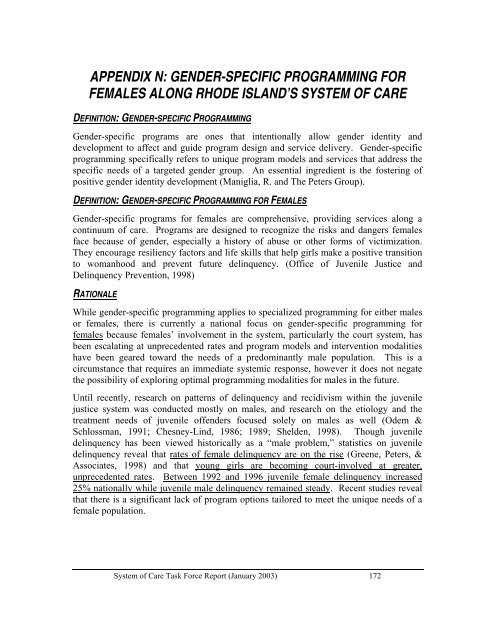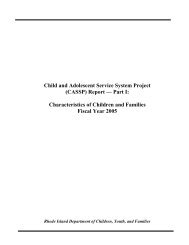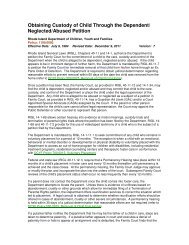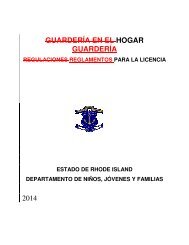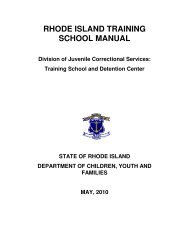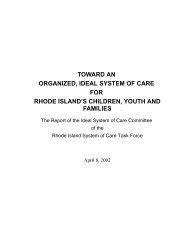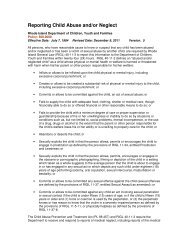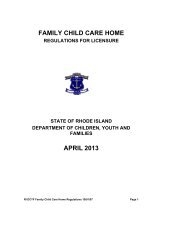Final Report - RI Department of Children, Youth & Families
Final Report - RI Department of Children, Youth & Families
Final Report - RI Department of Children, Youth & Families
You also want an ePaper? Increase the reach of your titles
YUMPU automatically turns print PDFs into web optimized ePapers that Google loves.
APPENDIX N: GENDER-SPECIFIC PROGRAMMING FOR<br />
FEMALES ALONG RHODE ISLAND’S SYSTEM OF CARE<br />
DEFINITION: GENDER-SPECIFIC PROGRAMMING<br />
Gender-specific programs are ones that intentionally allow gender identity and<br />
development to affect and guide program design and service delivery. Gender-specific<br />
programming specifically refers to unique program models and services that address the<br />
specific needs <strong>of</strong> a targeted gender group. An essential ingredient is the fostering <strong>of</strong><br />
positive gender identity development (Maniglia, R. and The Peters Group).<br />
DEFINITION: GENDER-SPECIFIC PROGRAMMING FOR FEMALES<br />
Gender-specific programs for females are comprehensive, providing services along a<br />
continuum <strong>of</strong> care. Programs are designed to recognize the risks and dangers females<br />
face because <strong>of</strong> gender, especially a history <strong>of</strong> abuse or other forms <strong>of</strong> victimization.<br />
They encourage resiliency factors and life skills that help girls make a positive transition<br />
to womanhood and prevent future delinquency. (Office <strong>of</strong> Juvenile Justice and<br />
Delinquency Prevention, 1998)<br />
RATIONALE<br />
While gender-specific programming applies to specialized programming for either males<br />
or females, there is currently a national focus on gender-specific programming for<br />
females because females’ involvement in the system, particularly the court system, has<br />
been escalating at unprecedented rates and program models and intervention modalities<br />
have been geared toward the needs <strong>of</strong> a predominantly male population. This is a<br />
circumstance that requires an immediate systemic response, however it does not negate<br />
the possibility <strong>of</strong> exploring optimal programming modalities for males in the future.<br />
Until recently, research on patterns <strong>of</strong> delinquency and recidivism within the juvenile<br />
justice system was conducted mostly on males, and research on the etiology and the<br />
treatment needs <strong>of</strong> juvenile <strong>of</strong>fenders focused solely on males as well (Odem &<br />
Schlossman, 1991; Chesney-Lind, 1986; 1989; Shelden, 1998). Though juvenile<br />
delinquency has been viewed historically as a “male problem,” statistics on juvenile<br />
delinquency reveal that rates <strong>of</strong> female delinquency are on the rise (Greene, Peters, &<br />
Associates, 1998) and that young girls are becoming court-involved at greater,<br />
unprecedented rates. Between 1992 and 1996 juvenile female delinquency increased<br />
25% nationally while juvenile male delinquency remained steady. Recent studies reveal<br />
that there is a significant lack <strong>of</strong> program options tailored to meet the unique needs <strong>of</strong> a<br />
female population.<br />
System <strong>of</strong> Care Task Force <strong>Report</strong> (January 2003) 172


